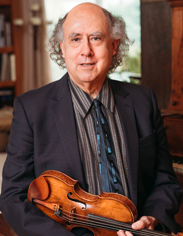|
Symphony
FROM THE NEW WORLD TO THE OLD WORLD
by Peter Lert
Saturday, June 14, 2025
Chamber
MC2 DUO RECITAL CLOSES 222'S SEASON
by Terry McNeill
Saturday, June 14, 2025
Choral and Vocal
CANTIAMO SONOMA'S LUSCIOUS A CAPELLA SINGING IN SEASON ENDING CONCERT
by Pamela Hicks Gailey
Sunday, June 8, 2025
Symphony
SRS SEASON ENDS WITH RESOUNDING TA-TA-TA-BANG
by Terry McNeill
Sunday, June 1, 2025
Symphony
YOUTHFUL VIRTUOSITY ON DISPLAY AT USO'S MAY CONCERTS
by Peter Lert
Saturday, May 17, 2025
Symphony
MYSTICAL PLANETS AND LIVELY GERSHWIN ORTIZ AT FINAL SRS CONCERT
by Peter Lert
Sunday, May 4, 2025
Symphony
VSO'S CONCERT MUSIC OF TIME, MUSIC OF PLACE
by Peter Lert
Sunday, April 27, 2025
VOCAL ELEGANCE AND FIRE AT THE 222'S RECITAL APRIL 26
by Pamela Hicks Gailey
Saturday, April 26, 2025
CANTIAMO SONOMA SINGS AN INSPIRED GOOD FRIDAY MOZART REQUIEM CONCERT
by Pamela Hicks Gailey
Friday, April 18, 2025
DRAMATIC SHOSTAKOVICH SYMPHONY CLOSES PHILHARMONIC'S 25TH SEASON
by Terry McNeill
Sunday, April 13, 2025
|
 |
 Violinist Joseph Edelberg |
SONIC CONTRASTS HIGHLIGHT SANTA ROSA SYMPHONY SPRING PROGRAM
by Terry McNeill
Sunday, April 25, 2021
In a curious mixture of compositions, the Santa Rosa Symphony’s penultimate virtual concert of the season April 25 unfolded in ways both highly satisfying and a bit perplexing.
Directed by resident Music Director Francesco Lecce-Chong, the event followed a familiar format – several contemporary works capped by a larger-scale familiar piece that seemed to sweep away the sonic memory of what came before. Presumably many program selections are dictated by the number of available musicians, the needs of the video recording, and COVID restrictions. Filming in Weill Hall was April 10.
Caroline Shaw’s Entr’acte for String Orchestra opened, a 2011 composition that Mr. Lecce-Chong took at a brisk clip over 12 minutes. Adelle-Kiko Kearns’ sorrowful cello line frequently echoed the pizzicato strings and the effective just-off-pitch demands of the score. Violinist Jay Zhong’s high register slides and string squeaks sounded unique, as did Ms. Kearns’ coda, where she played short phrases of swells and pauses, followed by softly strumming her instrument with guitar-like notes fading to an eerie silence.
Appearing for his ninth Symphony formal concert solo, concertmaster Joseph Edelberg played Ellen Taafe Zwilich’s Romance for Violin and Piano, also written in 2011. The initial music featured bassoonist Carla Wilson but quickly moved to Mr. Edelberg’s elegant interpretation, played from score, and equally quickly moving ahead to faster virtuoso playing that reminded one of Prokofiev’s Second Violin Concerto.
There was piquant flute playing from Kathleen Reynolds, and Mr. Edelberg made the most of the music’s periods of repose, his vibrato widening to a subdued ending.
Prior to intermission, instrumental solos were on display in Arturo Márquez’s Danzón No. 4 for Chamber Orchestra (1996), one of nine the Mexican composer has written. Here again Ms. Wilson’s bassoon started things off, paired with wood blocks from the percussion section. Then came thematic handoffs to oboe (Laura Reynolds), flute, horn (Meredith Brown), soprano sax and regular clarinet (Mark Wardlaw and Roy Zajac), muted trumpet (Scott Macomber), trombone (Kurt Patzner) and finally the not quite tango playing of pianist Kymry Esainko. The conductor meticulously shepherded the infectious rhythms and solo entries over 11 minutes that seemed short and were a concert highlight.
Tchaikovsky’s splendid C Major Serenade (Op. 48) concluded the concert, the attacks and releases mostly accurate and the 32 musicians seemingly enjoying the production of waves of rich late 19th Century sound. Low-end string sonority is critical to this Serenade, as is patrician phrasing and precise articulation. Mr. Lecce-Chong generally avoids extremes of tempo and especially rubato. This avoidance was most apparent in the super-romantic Élégie movement, where additional phrase ritards would have been welcome. More schmaltz? Hardly, but similar to the great horn solo in the composer’s E Minor Symphony, the big violin theme in the Élégie asks for subtle expansion of the lush melodic line, and here the conductor chose moderation.
That said, the six cellos and four basses supported glorious string playing in the charming Waltz movement, with some instruments muted. Mr. Lecce-Chong was in no hurry to get anywhere in the final Andante-Allegro. He deftly controlled instrumental sections and the musical excitement mounted, finishing with a triumphal string octave jump and a resounding short coda and long fermata.
Video production at this virtual concert was first cabin with ample close-ups of the musicians and excellent sound.
|

